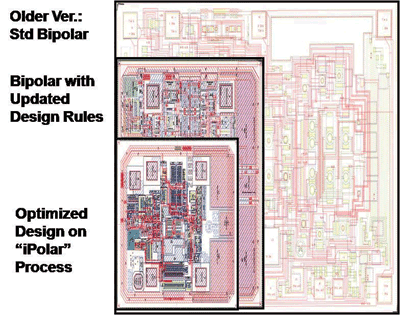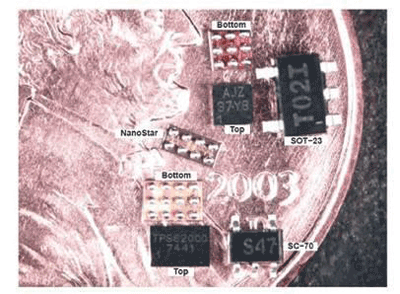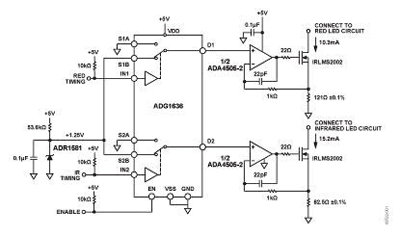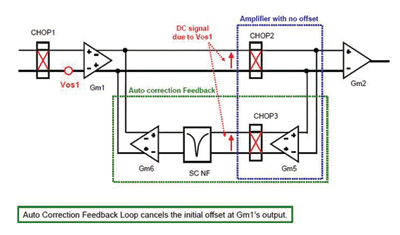Meeting the call for portable healthcare apps
How precision op amps play many different roles in optimizing the performance of mixed-signal ICs
BY REZA MOGHIMI
Analog Devices, Norword, MA
www.analog.com
Two trends that affect medical and industrial equipment designers are portability and the increasing use of their equipment in consumer and laboratory applications. Blood glucose monitors, multi-parameter blood analyzers, pulse oximeters, PH meters, and environmental monitors are examples of devices that were once confined to the lab, but that are now being used in portable applications.
Portable equipment must be small, light, and low power — without compromising performance. They are also very price sensitive. Recently, equipment manufacturers started using off-the-shelf parts instead of ASICs, reducing design costs and the time it takes to bring a new model to the market. Additionally, with drive to increased accuracy and platform flexibility, a one-chip-fits-all solution is difficult. Also, many smaller companies don’t have the funding to afford ASICs.
In medical and industrial systems, the measurement path starts with a sensor, whose output may be amplified, filtered, and level shifted before the ADC. Op amps, used in these and other signal conditioning circuits, play many different roles in optimizing the performance of mixed-signal designs, such as blood glucose monitors and pulse oximeters.
In portable applications, the signals being measured can be small compared to the common-mode signal, making technical requirements for op amps more demanding than ever. For instance, pulse oximeters measure the absorption of light through a finger, but most of the light is absorbed by the patient’s tissue. Only a small portion of the light is absorbed by fresh blood pumped through the finger, with the signal of interest typically being 0.1% to 2% of the total signal. Another challenge with medical instrumentation is electrical noise, as many medical devices such as wireless communicators, pumps, motors emit a lot of RF noise into the area around the patient. Further complicating the matter, most medical equipment uses long lead wires that can act like antennas for the unwanted signals. In addition, equipment and patients must be galvanically isolated from each other.
Amplifier advancements
Since the introduction of first op amp more than 40 years ago, huge advances in IC fabrication and circuit design have kept up with the changes in the end markets. The ideal amplifier, defined as having infinite open loop gain, infinite input impedance, zero bias current, zero offset voltage, and no noise, has been the ultimate target for analog designers, who have made tremendous progress on these technical fronts, but face new challenges due to changes in the marketplace and customer expectations. System designers now desire precision op amps with zero power consumption, zero package size, and zero cost. Op-amp manufacturers have responded with wide portfolios that come ever closer to meeting these requirements, and today’s op amps have wider bandwidth, lower noise, lower operating voltages, lower current consumption, smaller size, and lower cost than older parts. Today’s parts also provide more features and capabilities, a trend that will continue as signal-to-noise requirements increase, and as real-world signal processing takes place in more of our home appliances and industrial equipment.
IC manufacturers combine new processes, design techniques, package options, and manufacturing capabilities to produce parts that are, in effect, perfect for many of today’s challenging applications. Every application requires a different combination of specifications, and the number of available amplifiers continues to expand to fit those needs. An amplifier that is most suitable for measuring temperature may not be the best choice for photodiode detection and amplification.
Significant advances have occurred in all aspects of process technology. CMOS technologies developed primarily for digital circuits and microprocessors have been optimized for analog products, allowing amplifier designers to utilize their lower power consumption and lower costs, overcoming their inherently higher voltage noise to develop ultrahigh-performance amplifiers that were traditionally designed using bipolar technology. CMOS technology has allowed designers to combine low noise with super-low bias current to make better parts. New proprietary manufacturing processes, such as industrial CMOS (iCMOS®), have enabled the lowest noise CMOS amplifier (2.7 nV/√Hz @ 10 kHz) and a super-low supply current amplifier (1 μA/amplifier). Another benefit of CMOS is high input impedance, a highly desirable spec for many medical applications. New industrial bipolar processes, such as iPolar™ trench-isolation technology, have shrunk die sizes dramatically by combining state-of-the-art processing techniques and devices such as JFETS, allowing the industry standard OP07 to be shrunk by 60% so it can be offered in tiniest package possible (see figure 1 ). These new developments in process technologies have allowed amplifier designers to integrate features such as overvoltage protection (OVP), EMI filters, and high ESD rating diodes into their latest offerings. These features are very valuable in medical applications where the safety of user and reliability if the instrument is of utmost importance. For example, the ADA4091-2, dual 36 V, low-power op amp guarantees RRIO and OVP of 25 V above and below supply rail at ±5 V. In the world of JFET amplifiers, the low cost ADA4000-1 combines high input impedance, low input bias current, wide bandwidth, fast slew rate, and fast settling time in 5-lead TSOT package.

Fig 1. Die shrinkage made possible by new iPolar process.
Smaller packaging that does not sacrifice performance is one of the requirements of the portable world, and the previously stated performance improvements are all possible while continuing to shrink the die size. Die shrinkage allows IC manufacturers to fit it devices into the very small cavity available on super tiny packages, enabling op amp package sizes to become incredibly small, such as WLCSP, approaching levels that are hardly detectable by the naked eye. Savings on PCB area and weight are the benefit for portable applications. WLCSP devices take only about 8% of the space on PCBs as SOIC packages.

Fig. 2. Shrinking packages use very little PCB area.
IC design engineers have optimized many specifications using circuit and production test techniques, including Autozero, Chopping, Zero Crossover, Digitrim®, fuse blowing, and laser trimming, thus creating amplifiers that come close to ideal in a few specific parameters. In today’s world of precision amplifiers, small-signal designers have conquered critical challenges such as offset (2 μV), noise (1 nV/√Hz), and bias current (30 fA). Their innovative designs deliver high-performance parts that continue to exceed expectations. Zero crossover designs have produced op amps such as ADA4505-2 family, with very high CMRR, super low supply current and wide bandwidth (one of the best in industry)—all in an 8-ball wafer level chip scale package (WLCSP). An application example of this part in pulse oximetery is shown in Fig. 3 ( www.analog.com/en/circuits-from-the-lab/CN0125/vc.html).

Fig. 3. An application example using the ADA4505-2 op amp.
IC manufacturers also have addressed the Zero Power needs of portable applications. Low power helps to remove fans and their associated costs, reduces weight, and enables more portable products. Low power devices also generate less heat, prolonging the life of a part that could have been shortened due to heat damage. A few healthcare companies with ultra low power focus have done the power analysis and perform signal processing in the analog domain vs. digital. An example of an ultra-low-power op amp is the ADA4051-2 zero drift amplifier, which has been used in a number of portable glucose meters. For battery-powered applications where single AA or nickel metal hydride (NiMH) cell are used, size and power consumption are primary concerns. Operating supply voltages, already down to 1.8 V, are still being lowered. The AD8500, with its 1-μA supply current, is the best choice when precision, low-voltage operation, and low power consumption are all required. The drive towards single cell operation is on, and precision amplifiers will be available when needed.

Fig. 4. Architecture of ADA4051-2 zero-drift amplifier, one of the lowest powers to be offered in LFCSP
IC manufacturers also are working their way toward zero-cost parts. The cost of a part, which includes R&D expense, die cost, manufacturing cost, package cost, marketing, and distribution, has dramatically gone done. A single op amp such as OP07, which cost $1.50 in 1970, should now cost more than $8.00 when adjusted for inflation, but the OP1177, the fourth generation of the OP07, which has much better ac and dc specs, actually costs less than $0.80. The claim of zero cost may not be believable, but it definitely highlights the determination of IC companies to ongoing cost reduction despite both performance improvements and inflation. In addition, these new family of op amps bring tremendous value to customers. If one can design a front end using 16 op amps and use only 16 uA, that saves him 100s of microamperes and many dollars in memory, processing and software development.
Precision op amps have met the call for portable applications. Continued advances in process, design techniques, packaging technologies, and assembly techniques will continue to enable lower power, smaller packages and lower prices, providing medical and industrial system designers with increased functionality and performance for their products. Amplifiers, used in signal conditioning circuits of these portable systems, play an even more important role as the need for accurately conditioning a signal increases. Future design and package advances will provide even tighter specifications at lower prices. ■
Advertisement
Learn more about Analog Devices





